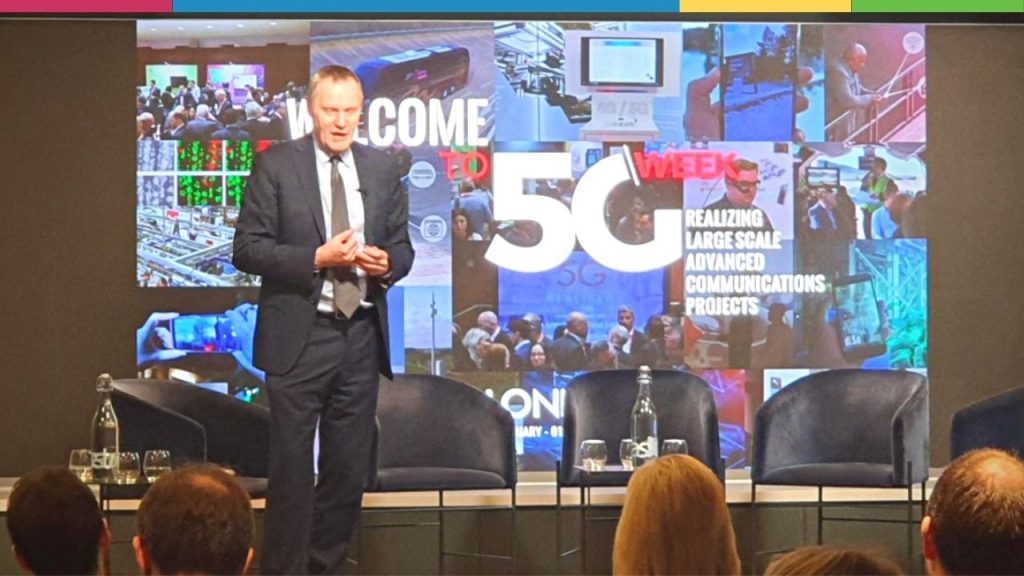The second day of 5G Week commenced with a welcome address from AWTG Chairman, Tony Sceales.
Today’s sessions explored how policy makers, investment firms and advisors are prepping up for increasing investment in 5G and discerning the potential of the market. A variety of speakers expressed their views on several topics.
Julia Lopez MP, Minister of State (DCMS) delivered the keynote address, emphasising the potential of 5G in revolutionising healthcare, fostering economic growth through connected and autonomous vehicles and empowering local governments to execute expeditious deployments. In addition, the Wireless Infrastructure Strategy is being formulated to promote investments in UK’s telecom and tech sectors. She noted that tangible applications of 5G that improve citizens’ lives and spur economic growth already exist.
The Panel Discussion, Global Perspective on Policy and Regulation, was attended by Cristina Data, Director of Spectrum Policy and Analysis from Ofcom. She shared that the spectrum will be accessible to eliminate roadblocks to deploying 5G technology, with UK leading Europe in launching 5G. Meanwhile, Paul Morris, Head of Government Affairs from Vodafone, discussed the grand opportunity 5G provides, by transforming the economy and bettering public services, particularly in the North of England. Furthermore, Ofcom enables everyone to explore their options with 5G. To the query on whether rural councils are disregarding customer demands, AWTG Chairman, Tony Sceales, noted that AWTG offers the requisite solutions and services to review the quality of services across operators.
The Real World Experiences – Vertical Markets panel discussion was chaired by Ian Corden, Managing Consultant from PA Consulting. Andy Welch, VP Strategy of Cartesian, shares that the chief areas that benefit from 5G and Wi-Fi are manufacturing, healthcare, transport, and logistics. PRIVINNET Co-founder and Chairman of EUWENA, Christian Regnier, foresees growth in these areas, mainly in the airline and space industries. Additionally, Simon Frumkin, CEO of Freshwave, reported that over 300 buildings are connected via Freshwave’s Neutral Hosts and that the technology is presently utilised for construction site surveillance.
The Fireside Chat – Looking Ahead, What Will Drive the Next Wave of Large Scale Projects? had Iain Thornhill, CTO Telco and Media for Microsoft, elaborating that Microsoft is applying insights and analytics in the enterprise cloud to upgrade efficiency with the help of automation and collaboration tools. An example of this was the deployment of a digital twin system for Coca Cola that allowed for real-time production data. AI (Artificial Intelligence), on the other hand, provides suggestions and courses of action through pooled data.
The Future Vision of Large Scale Places Projects – 6G, the Metaverse, future communications market panel discussion was participated in by Sylvia Lu, Head of Technology Strategy for Ublox and Martina Kurth, CEO and Founder of Telco Republic. While Ublox envisages an abrupt spike in the number of 5G terminals, the form factor remains an obstacle, and Telco Republic concentrates on the practical aspects of transformation such as OSS/BSS. Both agree that the success of IoT and seamless indoor-outdoor positioning in Industry 4.0 depends on 5G technology.
Professor Rahim Tafazolli, Regius Professor of Electronic Engineering, Director & Founder of the Institute of Communication Systems and 5G Innovation Centre at the University of Surrey, proposed that work on 6G should begin right away in order to make the most out of the advantages such as energy efficiency, reliability, and potential monetary benefits. Professor Rahim pointed out that connecting terrestrial (mobile) and space (satellite) networks, in addition to cost-effective and power-efficient technology for indoor deployments, is essential for smooth integration. In the future, it is believed that autonomous driving will be powered by human sensors. He additionally shared the details of the TUDOR project, sponsored by the DCMS and collaborated on by 8 academic and 16 industry partners including AWTG. The goal is to modify the network architecture to incorporate cloud, terrestrial and satellite networks with a focus on guaranteed latency, time synchronisation, time distribution and low latency.
To end the Day 2 sessions, Tony Sceales delivered a closing remark.

